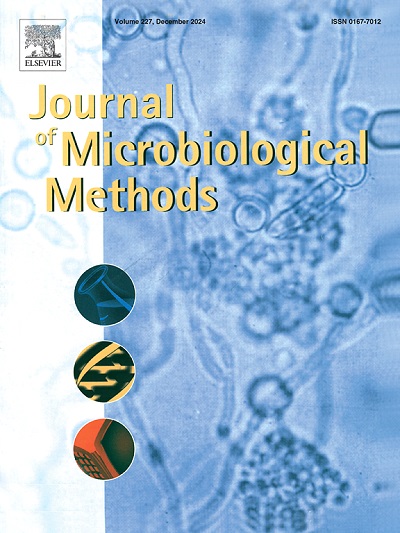Investigation of cagA, dupA and babA genes among clinical Helicobacter pylori isolates collected from patients suffering from H. pylori gastric disease using real-time PCR
IF 1.9
4区 生物学
Q4 BIOCHEMICAL RESEARCH METHODS
引用次数: 0
Abstract
Background
Helicobacter pylori (H. pylori) infection causes chronic gastritis and can lead to severe gastrointestinal diseases, including stomach ulcers, stomach cancer, and mucosa-associated lymphoid tissue (MALT) lymphoma. This infection affects about half of the world's population, with varying prevalence based on location and hygiene standards. Determining the importance of H. pylori pathogenic genes in predicting clinical outcomes is crucial, especially considering high rates of stomach cancer in Middle Eastern and Asian populations. The main aim of this study was to determine the frequency of the babA, cagA, and dupA pathogenic genes in H. pylori isolates obtained from patients with gastrointestinal diseases.
Methods
A urease test was conducted on 111 biopsies from the antrum of patients undergoing endoscopies at Tehran hospitals. Following this, an extraction kit was used, and the Real-time PCR technique determined the frequency of the babA, cagA, and dupA genes.
Results
Out of 111 stomach biopsies, 70 tested positive for H. pylori. Molecular analysis showed that the frequency of babA, cagA, and dupA genes was 51 (72.8 %), 35 (50 %), and 26 (37.14 %), respectively.
Conclusion
The results showed that babA and cagA genes were identified with a higher abundance among patients and the findings suggest that the presence of these genes could be considered a risk indicator for exacerbation of gastrointestinal disease. Additionally, the dupA gene was found with lower frequency, which is less likely to play a significant role in pathogenicity compared to other genes. This study could help develop more effective prevention and treatment methods in the future.
实时荧光定量PCR检测胃病幽门螺杆菌临床分离株cagA、dupA和babA基因
背景幽门螺杆菌感染可引起慢性胃炎,并可导致严重的胃肠道疾病,包括胃溃疡、胃癌和粘膜相关淋巴组织(MALT)淋巴瘤。这种感染影响到世界上大约一半的人口,其流行程度因地点和卫生标准而异。确定幽门螺杆菌致病基因在预测临床结果中的重要性是至关重要的,特别是考虑到中东和亚洲人群中胃癌的高发病率。本研究的主要目的是确定从胃肠道疾病患者获得的幽门螺杆菌分离株中babA、cagA和dupA致病基因的频率。方法对德黑兰多家医院内窥镜检查患者的胃窦活检标本111例进行脲酶试验。随后,使用提取试剂盒,Real-time PCR技术测定babA、cagA和dupA基因的频率。结果111例胃活检中,幽门螺杆菌阳性70例。分子分析显示,babA、cagA和dupA基因的频率分别为51(72.8%)、35(50%)和26(37.14%)。结论babA和cagA基因在患者中丰度较高,提示这些基因的存在可能是胃肠道疾病恶化的危险指标。此外,dupA基因的发现频率较低,与其他基因相比,dupA基因在致病性中起显着作用的可能性较小。这项研究有助于在未来开发更有效的预防和治疗方法。
本文章由计算机程序翻译,如有差异,请以英文原文为准。
求助全文
约1分钟内获得全文
求助全文
来源期刊

Journal of microbiological methods
生物-生化研究方法
CiteScore
4.30
自引率
4.50%
发文量
151
审稿时长
29 days
期刊介绍:
The Journal of Microbiological Methods publishes scholarly and original articles, notes and review articles. These articles must include novel and/or state-of-the-art methods, or significant improvements to existing methods. Novel and innovative applications of current methods that are validated and useful will also be published. JMM strives for scholarship, innovation and excellence. This demands scientific rigour, the best available methods and technologies, correctly replicated experiments/tests, the inclusion of proper controls, calibrations, and the correct statistical analysis. The presentation of the data must support the interpretation of the method/approach.
All aspects of microbiology are covered, except virology. These include agricultural microbiology, applied and environmental microbiology, bioassays, bioinformatics, biotechnology, biochemical microbiology, clinical microbiology, diagnostics, food monitoring and quality control microbiology, microbial genetics and genomics, geomicrobiology, microbiome methods regardless of habitat, high through-put sequencing methods and analysis, microbial pathogenesis and host responses, metabolomics, metagenomics, metaproteomics, microbial ecology and diversity, microbial physiology, microbial ultra-structure, microscopic and imaging methods, molecular microbiology, mycology, novel mathematical microbiology and modelling, parasitology, plant-microbe interactions, protein markers/profiles, proteomics, pyrosequencing, public health microbiology, radioisotopes applied to microbiology, robotics applied to microbiological methods,rumen microbiology, microbiological methods for space missions and extreme environments, sampling methods and samplers, soil and sediment microbiology, transcriptomics, veterinary microbiology, sero-diagnostics and typing/identification.
 求助内容:
求助内容: 应助结果提醒方式:
应助结果提醒方式:


